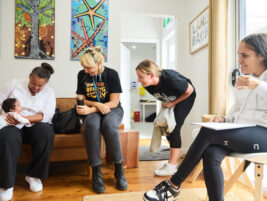Given its universality and salience to parents throughout the world, it is amazing that, until about 30 years ago, there was so little research on infant crying. So little, in fact, that there was hardly anything known about it except that it happened. There has since been a small explosion of studies. These studies have made a difference. We have changed our conceptualization of what early crying is about, of factors that affect the way parents respond, and of its consequences.
It may seem simple, but the realization that crying can be different at different developmental stages (before and after 4 months of age approximately) is an important breakthrough. The studies of Stifter, Zeifman, St. James-Roberts, Barr and Lehtonen all indicate that early increased crying—including the prolonged inconsolable crying bouts that so irritate care givers—is actually a normal developmental phenomenon that occurs in completely normally developing infants. Furthermore, the outcome for these infants is excellent. It is more of a challenge, however, if an infant has persistent fussiness throughout infancy. This is indicative of a normal individual difference referred to as “ difficult temperament.” As Zeifman notes, parental training in sensitivity and responsiveness to these infants can be beneficial.
The key, as Zeifman, Zeskind, and Oberlander point out, is how the parents respond to these frustrating properties of crying. As St. James-Roberts and colleagues showed, cultural differences in responding vary widely, but do not affect the increased inconsolable crying. On top of that, if the mother is unfortunate enough to experience post partum depression just when this normal increased crying occurs, the cry signal may be read differently resulting in over-responding or under-responding, but in either case less reliably then could be wished.
Anyone who has experienced the worst of this inconsolable crying would admit that it is counterintuitive to think of it as “ normal.” Being able to understand that, from the evolutionary point of view, lusty, strong crying has been helpful for infants who might receive too little care giving in the first post partum weeks, and that they turn out normally, is an important new way to think about this behavior. If thinking of increased crying as normal became the cultural norm, the anger generated by this age-old behavior might be reduced. This is an important public health target to achieve. It is now clear that it is the anger from this normal infant behavior that triggers most early traumatic brain injury (or shaken baby syndrome). In fact, the dire consequences (death, blindness and motor challenges) of shaken baby syndrome are the only significant negative long term clinical consequences of early increased crying. It is not the crying, but the care givers response to the crying that is the key. That gives us all something important to do; namely, to make sure that we and everyone who takes care of infants know that, no matter how frustrating it gets, never ever shake an infant in frustration.
What is all that crying about?
Authors
Barr, Ronald G., MDCM, FRCPC Canada Research Chair
Child and Family Research Institute, Vancouver, BC
Canada








